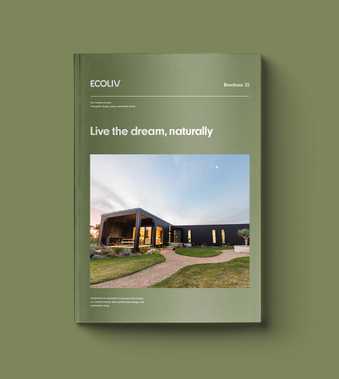Get in touch
Phone +61 (03) 5672 5196
Email info@ecoliv.com.au
Sustainable Prefab Homes
Australian modular home builders
Thinking about building a prefab home but not sure where to start? Ecoliv has designed and built award winning prefab modular homes for Australian families for more than 13 years. Whether you live in an urban area or are planning on going off-grid, our innovative approach to designing and building prefab homes means we’ll have a floor plan to suit your needs – and if we don’t, we can create a custom modular home just for you. All Ecoliv prefabricated modular homes are designed and built at The EcoHub – our sustainable living centre and off-grid design and construction facility located at The Gurdies on Victoria’s Bass Coast.
Designing with modules
Prefab construction refers to the process of building entire homes, or components of the home – from wall systems to facades – in a prefab construction facility completely off-site.
Prefab houses are made up of sections (also known as volumetric modules) that are designed to meet the size and weight limits required to be transported by road to their final destination and positioned on site. At Ecoliv, our modular homes are built at The EcoHub –our construction facility – located at The Gurdies on Victoria’s Bass Coast.
With a focus on reducing build timelines and total production costs, our methodology embraces a construction process known as Design for Manufacture and Assembly (DfMA). By creating a selection of modules and volumetric floor plans that work together we’re able to construct homes more efficiently, in the minimum time.
Each module is designed to either make up an entire small dwelling (like our EcoHut one bedroom cabins) or combine with other modules to create a larger home (like our EcoLiving, EcoSanctuary and EcoGeneration homes.
Better for you. Better for the planet.
Unlike the traditional home building process which is completed on-site, our prefabricated homes are built off-site at The EcoHub, then transported to you and connected to services. This means your site isn’t disturbed and there are zero emissions associated with the construction process.
In addition to faster build times and potential cost savings, prefab construction can reduce construction waste. Embracing the DfMA construction process and using precision-designed volumetric modules, Ecoliv prefab homes minimise materials wastage and can reduce overall construction waste by up to 52%.
Plus by taking a passive solar approach to design, Ecoliv prefab homes come with a 7-star energy efficiency rating and a host of other sustainability benefits. In fact, you could save approximately 30% on running costs each year across power usage for heating and cooling, lighting and appliances.
Choosing a modular home is easy with Ecoliv
Building a new home is known to be one of the most stressful things you can do. But it doesn’t have to be. At Ecoliv, we’ve simplified the prefab building process making it an easy, transparent and enjoyable journey where you know exactly what to expect and when – right up to handing over the keys to your new home.
4 stages to your new prefab home
In stage 1, we guide you through the pre-construction journey to ensure the home design suits your site and minimises environmental impact. We’ll work with you to choose an Ecoliv house design that’s perfect for your site orientation and requirements.
During stage 2, we take care of design documentation during the approvals phase to ensure the process runs smoothly.
Stage 3 and it’s time to make it official – we’ll review and finalise your contract documents, ensuring all details are in place. Upon signing, you’ll receive the necessary insurance certificates, including domestic builders and project-specific warranty coverage.
Finally, in stage 4, we’ll begin building your brand new Ecoliv home at The EcoHub – our sustainable living centre and off-grid construction facility. Over approximately 20 weeks, your Ecoliv home will be constructed and then transported to your site ready to connect to services.
Live the dream, naturally in a factory built Ecoliv prefab modular home.
With over 13 years of experience, Ecoliv has committed to creating sustainable 7-star rated energy-efficient homes with stunning, contemporary designs.
We can design a custom home to suit your site and project requirements. To achieve a minimum 7-star energy rating our expert designers will provide site-specific advice on siting, layout and orientation.
Want to learn more? Book an appointment to come visit our new display home located at The EcoHub at The Gurdies on Victoria’s Bass Coast.
Discover our EcoHut, EcoGeneration, and EcoLiving prefab house designs or view our featured builds to see what’s possible with an Ecoliv custom design.
Prefab homes FAQs
Our most frequently asked questions about choosing a prefab home.
Wondering what makes a prefab home? Short for prefabrication, prefab home refers to homes that are built by the prefab construction process – where homes are built off-site in panels, components or modules for assembly and connection to services on-site. Because the term ‘prefab homes’ refers to the type of construction, there’s not one single style of prefab home. For this reason, modular and kit homes are both considered prefab homes. Though modular homes are typically delivered to site complete and ready for connection to services whereas kit homes are delivered in components for assembly on-site.
If you’ve been feeling a little confused about prefab vs modular construction vs kit homes, you’re not alone. A prefabricated building is a broad term that describes a pre-designed building structure which is constructed either partially or fully off-site. Which means kit homes and modular homes are types of prefab homes. Ecoliv designs and builds sustainable homes utilising the prefab construction process and embracing design for manufacture and assembly (DfMA) and passive solar design principles in a complete volumetric module.
Read more about the different types of prefab buildings and the pros and cons of prefab vs traditional construction on our blog.
Our prefab homes are made up of volumetric modules which are transported on flat-bed trucks to their final destination. Ecoliv’s prefab modular homes can be transported from our construction facility at The Gurdies on Victoria’s Bass Coast to any location in Australia.
Transport costs are dependent on the distance of travel required and the number of modules. An estimate is calculated early on at the preliminary estimate stage. The cost is estimated at approximately $1,000 per hour per truck per module from our construction facility to your site.
As is true of any new home, the cost of constructing a prefab home depends on its size and inclusions. Ecoliv prefab modular building designs start from $228,000 and you’ll have the option to upgrade things like cladding, interior materials, and fixtures as desired or opt for a completely custom design. Distance from the factory and local building codes can also influence the final prefab home cost.
Learn about financing your modular home build on our blog.
\Prefab modular homes are structurally engineered for transport and craning resulting in each home being constructed to a higher quality than a traditional build.
Ecoliv prefab homes can be designed to suit any climate in Australia and come with the same warranties as a traditional build. Each home will be designed to harness site-specific features such as orientation and cross-flow ventilation. Plus our homes can be designed up to a bushfire attack level (BAL) rating of BAL FZ.
While the prefab construction process can reduce construction waste, it’s important to note that not all modular or panel home builders are sustainable builders. Equally important to the sustainability of the home, in both its construction and its occupancy, is the quality of the build and materials used – which can vary depending on the specifications and budgets. Sustainable prefab construction relies on the precise planning and building of modular homes to reduce wastage. Homes must also be designed with passive solar principles and utilise low embodied energy materials which results in reduced overall environmental impact. We’ve been building 7-star energy efficiency rated modular homes in Australia for more than 13 years using sustainable construction principles to reduce waste.
There are many benefits of prefab homes. In addition to faster build times, cost effective processes, reduced construction waste and fewer negative environmental impacts, our prefab homes can be easily transported to any location within Australia.
This makes prefab homes a great option for those seeking to build a new home in a remote or rural area within Australia – where there are often fewer tradespeople and associated businesses (such as materials and hardware stores). Like this Ecoliv home in Jindabyne, NSW – a remote location with little access to skilled construction people or services.
Prefab homes are also suitable for highly urbanised areas as there is minimal construction noise as prefab building is constructed off-site and delivered to the site. Our Northcote Project, Victoria is an example of a sustainable modular home in a highly urbanised environment in Melbourne.

Enter your details to receive the Ecoliv brochure including our complete range, process, and sustainability guide.
